8
Southern Okanagan Irrigation Works Syphon at Fairview20th Century, Circa 1920
Oliver, British Columbia, Canada
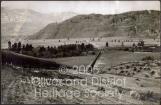 Credits:
Credits:Johnstone, James Cameron
9
Safety along the rocky cliffs was a constant concern, as was the integrity of the ditch. Inspectors and engineers worked alongside construction crews to ensure consistent quality and stability.10
Inspectors at Southern Okanagan Irrigation Project camp20th Century, Circa 1920's
Oliver, British Columbia, Canada
 Credits:
Credits:Johnstone, James Cameron
11
Construction on the canal was not without hazard, however. Along McIntyre Bluff and the Gallagher Lake cliffs, rockslides were a regular occurrence. Wooden covering was put into place to try and protect the flumes and canal, but these proved insufficient on their own. Eventually, the paneling would be augmented by a complete gravel covering, which exists to this day.12
Damage to the Flume caused by cliff debris20th Century, 1940-1970
Oliver, British Columbia, Canada
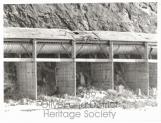 Credits:
Credits:Southern Okanagan Lands Project
13
As construction of the canal progressed, and more land became available for agriculture, the town steadily grew. Some people did not come to the Oliver townsite to establish farms. Services and businesses began to develop, appealing to construction workers and farmers alike.14
East side of Oliver mainstreet showing Gent's Furnishings20th Century, Circa 1920's
Oliver, British Columbia, Canada
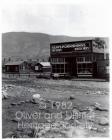 Credits:
Credits:Mrs. Mabee, George
15
Regularly, the Okanagan River flooded its banks, and threatened to wash out the siphon. While no major damage was incurred, the incident prompted the Project engineers to consider better protecting Oliver's irrigation.16
Oliver syphon during the flood of 192420th Century, Circa 1924
Oliver, British Columbia, Canada
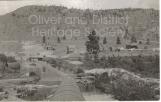 Credits:
Credits:Oliver and District Heritage Society
17
In response to the 1924 flood, reinforcing wooden braces were constructed around the siphon in addition to the ground supports. These would reduce flex in the pipe, and protect it from floods and other natural ocurrences.18
Syphon crossing Okanagan River on a truss bridge20th Century, 1922-1930
Oliver, British Columbia, Canada
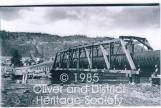 Credits:
Credits:Oliver and District Heritage Society
19
Seventy-two inches in diameter, and originally constructed with wooden-stave piping, the siphon was to carry water from the valley side east of Oliver, under the town, to the west-lateral flume and the west side continuation of the Ditch.For safety and reliability reasons, only the portions of the siphon to be constructed above-ground were made of wooden-stave piping. Over 1700 feet of the siphon was made this way, at a cost just under $30,500. The portion of the pipe to be built beneath the town measured over 1800 feet long, and was constructed from steel piping protected by heavy coats of asphalt paint. It was priced at $26 per foot, with a total price of $47,268. In total, the siphon cost just under $78,000.
20
Southern Okanagan Irrigation Syphon view from Fairview20th Century, Circa 1920
Oliver, British Columbia, Canada
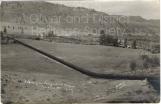 Credits:
Credits:Johnstone, James Cameron